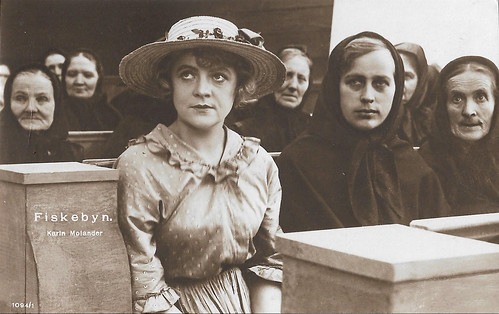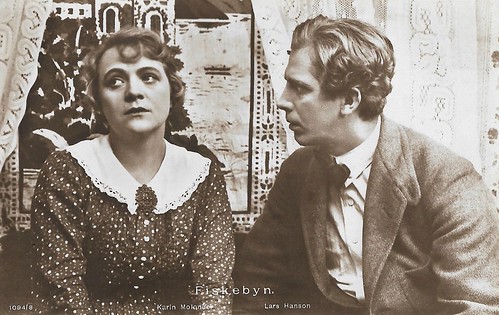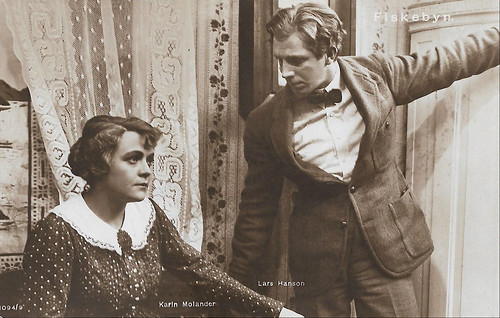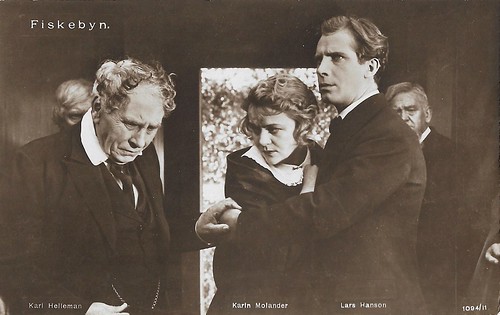Lars Hanson and Karin Molander played the leading roles in the Swedish silent rural drama Fiskebyn/The Fishing Village (Mauritz Stiller, 1920). In the films of Mauritz Stiller, Molander became a symbol of the modern, young and emancipated women of the 1910s. Hanson was one of the best-known stars of the Scandinavian silent cinema, who also had a career in Hollywood. In real life, Hanson and Molander were a couple too.

Swedish postcard by Förlag Nordisk Konst, Stockholm, no. 1094/1. Photo: Svenska Biografteatern, Stockholm. Publicity still of Karin Molander in Fiskebyn/The Fishing Village (Mauritz Stiller, 1920).

Swedish postcard by Förlag Nordisk Konst, Stockholm, no. 1094/2. Photo: Svenska Biografteatern, Stockholm. Publicity still of Lars Hanson and Karin Molander in Fiskebyn/The Fishing Village (Mauritz Stiller, 1920).

Swedish postcard by Förlag Nordisk Konst, Stockholm, no. 1094/3. Photo: Svenska Biografteatern, Stockholm. Publicity still of Karin Molander and Käte Schnitzer in Fiskebyn/The Fishing Village (Mauritz Stiller, 1920).

Swedish postcard by Förlag Nordisk Konst, Stockholm, no. 1094/4. Photo: Svenska Biografteatern, Stockholm. Publicity still of Karin Molander and Egil Eide in Fiskebyn/The Fishing Village (Mauritz Stiller, 1920).

Swedish postcard by Förlag Nordisk Konst, Stockholm, no. 1094/5. Photo: Svenska Biografteatern, Stockholm. Publicity still of Karin Molander and Egil Eide in Fiskebyn/The Fishing Village (Mauritz Stiller, 1920).
Fiskebyn/The Fishing Village (Mauritz Stiller, 1920) is situated in a small, rugged fishing village on the west coast of Sweden. The community is permeated by the Puritan spirit and Schartauanism, a revivalist movement influenced by the Lutheran priest Henric Schartau and which is widespread in south and southwest Sweden. The local priest (Nils Arehn) is a tough man who controls his congregation boys with an iron hand. Jakob Vindås (Egil Eide), a widower, lives in the village with his daughter and mother (Hildur Carlberg). The latter is even more unbearable than the priest. The school teacher Rilke (Carl Helleman) also lives in the village, together with his son Thomas (Lars Hanson), who studied for three years at the university, and the orphan girl Martina (Karin Molander).
Jakob wants to marry Martina and the priest gives him permission, but his mother denies the marriage harshly. Meanwhile, Martina and Thomas have fallen in love with each other. They meet in a crowded place on the island and bathe together there, completely naked but in all chastity. They do not even kiss each other. Yet, someone has seen them without clothes, and the gossip goes like a rush through society. The priest orders the school teacher to immediately send Thomas away or look after another job. Thomas leaves the village.
Later, when Thomas returns, Martina is married to Jakob. She assures Jakob that her past with Thomas is dead and forgotten. Calmly, Jakob goes on a fishing trip, which will last for 14 days. Only the night before Jakob is expected back, Thomas and Martina meet again after their long separation. Thomas now knows that the priest forced Martina to marry Jacob. "But now it's all too late," says Martina. Thomas goes resigned, but at the door, he kisses Martina in parting. The door opens and Mother Vindås is on the doorstep. She rushes out and returns immediately with the priest. A bold appearance follows as the priest concludes with the words: "Tomorrow the whole village will know your shame!"
The next day, on Sunday, the whole village is gathered in the church, including Martina, Thomas, and his father. From the pulpit, the priest holds a sulfurous punishment over the traitor Thomas and the unfaithful wife Martina. Then he wants to chase them out of the church and the community. But Thomas and Martina do not have to go alone. Thomas's father joins them and Jakob's little daughter (Käte Schnitzer) also runs out after Martina. Meanwhile, Jakob has come home, and his mother tells him what has happened. Thomas and Martina have resorted to the school teacher's house. The villagers have gathered there and throw stones at the house. But when Jacob arrives, he does not do what everyone is waiting for. He instead drives the people away. He enters the house and asks Martina forgiveness: "You're free to follow him. It should never have been otherwise. I am too old, my hands too rough for you."
The shooting of Fiskebyn took place at the Svenska Biografteatern studio at Lidingö with exterior scenes shot in Fiskebäckskil (in Västra Götaland County), on the island Gåsö and at several locations in the Swedish province of Bohuslän. Henrik Jaenzon took care of the cinematography. The film was based on Georg Engel's play Im Hafen, published in Berlin in 1905. During and after the shooting, scriptwriter Bertil Malmberg revised the manuscript into a novel of the same name, published just before Christmas 1919. Fiskebyn/The Fishing Village (Mauritz Stiller, 1920) premiered on 15 March 15 1920. The bath in the nude of Hanson and Molander did not raise any major upheaval although the film was also exported to a number of Catholic countries. But for the foreign market, the role of the priest was changed into the chairman of the village council and all the shots with the church were cut out of the film. In Great Britain, Fiskebyn was released under the title Chains. The film is believed to be lost.

Swedish postcard by Förlag Nordisk Konst, Stockholm, no. 1094/6. Photo: Svenska Biografteatern, Stockholm. Publicity still of Karin Molander and Lars Hanson in Fiskebyn/The Fishing Village (Mauritz Stiller, 1920).

Swedish postcard by Förlag Nordisk Konst, Stockholm, no. 1094/7. Photo: Svenska Biografteatern, Stockholm. Publicity still of Karin Molander in Fiskebyn/The Fishing Village (Mauritz Stiller, 1920).

Swedish postcard by Förlag Nordisk Konst, Stockholm, no. 1094/8. Photo: Svenska Biografteatern, Stockholm. Publicity still of Karin Molander and Lars Hanson in Fiskebyn/The Fishing Village (Mauritz Stiller, 1920).

Swedish postcard by Förlag Nordisk Konst, Stockholm, no. 1094/9. Photo: Svenska Biografteatern, Stockholm. Publicity still of Karin Molander and Lars Hanson in Fiskebyn/The Fishing Village (Mauritz Stiller, 1920).

Swedish postcard by Förlag Nordisk Konst, Stockholm, no. 1094/10. Photo: Svenska Biografteatern, Stockholm. Publicity still of Karin Molander, Hildur Carlberg, and Lars Hanson in Fiskebyn/The Fishing Village (Mauritz Stiller, 1920).

Swedish postcard by Förlag Nordisk Konst, Stockholm, no. 1094/11. Photo: Svenska Biografteatern, Stockholm. Publicity still of Carl Helleman, Karin Molander and Lars Hanson in Fiskebyn/The Fishing Village (Mauritz Stiller, 1920).
Sources: Svenskfilmdatabas.se, Wikipedia (Swedish), and IMDb.

Swedish postcard by Förlag Nordisk Konst, Stockholm, no. 1094/1. Photo: Svenska Biografteatern, Stockholm. Publicity still of Karin Molander in Fiskebyn/The Fishing Village (Mauritz Stiller, 1920).

Swedish postcard by Förlag Nordisk Konst, Stockholm, no. 1094/2. Photo: Svenska Biografteatern, Stockholm. Publicity still of Lars Hanson and Karin Molander in Fiskebyn/The Fishing Village (Mauritz Stiller, 1920).

Swedish postcard by Förlag Nordisk Konst, Stockholm, no. 1094/3. Photo: Svenska Biografteatern, Stockholm. Publicity still of Karin Molander and Käte Schnitzer in Fiskebyn/The Fishing Village (Mauritz Stiller, 1920).

Swedish postcard by Förlag Nordisk Konst, Stockholm, no. 1094/4. Photo: Svenska Biografteatern, Stockholm. Publicity still of Karin Molander and Egil Eide in Fiskebyn/The Fishing Village (Mauritz Stiller, 1920).

Swedish postcard by Förlag Nordisk Konst, Stockholm, no. 1094/5. Photo: Svenska Biografteatern, Stockholm. Publicity still of Karin Molander and Egil Eide in Fiskebyn/The Fishing Village (Mauritz Stiller, 1920).
Completely naked but in all chastity
Fiskebyn/The Fishing Village (Mauritz Stiller, 1920) is situated in a small, rugged fishing village on the west coast of Sweden. The community is permeated by the Puritan spirit and Schartauanism, a revivalist movement influenced by the Lutheran priest Henric Schartau and which is widespread in south and southwest Sweden. The local priest (Nils Arehn) is a tough man who controls his congregation boys with an iron hand. Jakob Vindås (Egil Eide), a widower, lives in the village with his daughter and mother (Hildur Carlberg). The latter is even more unbearable than the priest. The school teacher Rilke (Carl Helleman) also lives in the village, together with his son Thomas (Lars Hanson), who studied for three years at the university, and the orphan girl Martina (Karin Molander).
Jakob wants to marry Martina and the priest gives him permission, but his mother denies the marriage harshly. Meanwhile, Martina and Thomas have fallen in love with each other. They meet in a crowded place on the island and bathe together there, completely naked but in all chastity. They do not even kiss each other. Yet, someone has seen them without clothes, and the gossip goes like a rush through society. The priest orders the school teacher to immediately send Thomas away or look after another job. Thomas leaves the village.
Later, when Thomas returns, Martina is married to Jakob. She assures Jakob that her past with Thomas is dead and forgotten. Calmly, Jakob goes on a fishing trip, which will last for 14 days. Only the night before Jakob is expected back, Thomas and Martina meet again after their long separation. Thomas now knows that the priest forced Martina to marry Jacob. "But now it's all too late," says Martina. Thomas goes resigned, but at the door, he kisses Martina in parting. The door opens and Mother Vindås is on the doorstep. She rushes out and returns immediately with the priest. A bold appearance follows as the priest concludes with the words: "Tomorrow the whole village will know your shame!"
The next day, on Sunday, the whole village is gathered in the church, including Martina, Thomas, and his father. From the pulpit, the priest holds a sulfurous punishment over the traitor Thomas and the unfaithful wife Martina. Then he wants to chase them out of the church and the community. But Thomas and Martina do not have to go alone. Thomas's father joins them and Jakob's little daughter (Käte Schnitzer) also runs out after Martina. Meanwhile, Jakob has come home, and his mother tells him what has happened. Thomas and Martina have resorted to the school teacher's house. The villagers have gathered there and throw stones at the house. But when Jacob arrives, he does not do what everyone is waiting for. He instead drives the people away. He enters the house and asks Martina forgiveness: "You're free to follow him. It should never have been otherwise. I am too old, my hands too rough for you."
The shooting of Fiskebyn took place at the Svenska Biografteatern studio at Lidingö with exterior scenes shot in Fiskebäckskil (in Västra Götaland County), on the island Gåsö and at several locations in the Swedish province of Bohuslän. Henrik Jaenzon took care of the cinematography. The film was based on Georg Engel's play Im Hafen, published in Berlin in 1905. During and after the shooting, scriptwriter Bertil Malmberg revised the manuscript into a novel of the same name, published just before Christmas 1919. Fiskebyn/The Fishing Village (Mauritz Stiller, 1920) premiered on 15 March 15 1920. The bath in the nude of Hanson and Molander did not raise any major upheaval although the film was also exported to a number of Catholic countries. But for the foreign market, the role of the priest was changed into the chairman of the village council and all the shots with the church were cut out of the film. In Great Britain, Fiskebyn was released under the title Chains. The film is believed to be lost.

Swedish postcard by Förlag Nordisk Konst, Stockholm, no. 1094/6. Photo: Svenska Biografteatern, Stockholm. Publicity still of Karin Molander and Lars Hanson in Fiskebyn/The Fishing Village (Mauritz Stiller, 1920).

Swedish postcard by Förlag Nordisk Konst, Stockholm, no. 1094/7. Photo: Svenska Biografteatern, Stockholm. Publicity still of Karin Molander in Fiskebyn/The Fishing Village (Mauritz Stiller, 1920).

Swedish postcard by Förlag Nordisk Konst, Stockholm, no. 1094/8. Photo: Svenska Biografteatern, Stockholm. Publicity still of Karin Molander and Lars Hanson in Fiskebyn/The Fishing Village (Mauritz Stiller, 1920).

Swedish postcard by Förlag Nordisk Konst, Stockholm, no. 1094/9. Photo: Svenska Biografteatern, Stockholm. Publicity still of Karin Molander and Lars Hanson in Fiskebyn/The Fishing Village (Mauritz Stiller, 1920).

Swedish postcard by Förlag Nordisk Konst, Stockholm, no. 1094/10. Photo: Svenska Biografteatern, Stockholm. Publicity still of Karin Molander, Hildur Carlberg, and Lars Hanson in Fiskebyn/The Fishing Village (Mauritz Stiller, 1920).

Swedish postcard by Förlag Nordisk Konst, Stockholm, no. 1094/11. Photo: Svenska Biografteatern, Stockholm. Publicity still of Carl Helleman, Karin Molander and Lars Hanson in Fiskebyn/The Fishing Village (Mauritz Stiller, 1920).
Sources: Svenskfilmdatabas.se, Wikipedia (Swedish), and IMDb.
No comments:
Post a Comment